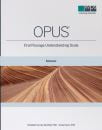
Oral Passage Understanding Scale opus
For: Assesses listening comprehension in ages 5 to 21 years
Format: Paper-and-Pencil, PC Based Software
Length: 30 to 45 minutes for the core battery
Scoring: Hand Scored; Computer Scored
Online Forms, Reports, Kits & e-Manuals
All online resources including Forms, Reports, i-Admins, Kits and e-Manuals.
Printed Manuals
Physical printed manuals.
Printed Kits
Click to browse products
Printed Forms & Handscoring Materials
Test forms, response booklets and scoring reference manuals.
Books & Workbooks
Click to browse products
OPUS Digital Easel
OPUS Manual
OPUS Online Manual
OPUS Kit
OPUS Form (Pack of 10)
OPUS Easel
Authors
Elizabeth Carrow-Woolfolk, PhD and Amber M. Klein, PhD
Description
The Oral Passage Understanding Scale (OPUS) is a new measure of listening (auditory) comprehension. It evaluates a person’s ability to listen to passages that are read aloud and recall information about them. This ability is key to success in the classroom, as well as in social and occupational settings. The OPUS also measures memory skills, which are integral to listening comprehension.
The OPUS shares the same underlying theory as the new Comprehensive Assessment of Spoken Language, Second Edition (CASL-2) and the Oral and Written Language Scales, Second Edition (OWLS-II). Since all three tests are based on the author’s Integrative Language Theory, they provide a cohesive evaluation across a broad range of language areas. While the OWLS-II provides an evaluation of oral and written language abilities, the CASL-2 offers a more in-depth picture of 14 spoken language skills. The new OPUS takes this a step further and tells you how well a person can integrate and apply many of these skills. Although it’s an excellent companion test to the CASL-2, you may also use it on its own anytime you need to quickly measure listening comprehension.
A versatile instrument, the OPUS may be used by speech language pathologists and other professionals in a variety of settings, including schools, clinics, hospitals, private practices and intervention programs. When you need to evaluate response to intervention (RTI), you may use the OPUS to track improvement over time. It may also help you answer a variety of referral questions. For example:
Can a student sufficiently understand and retain information heard in class?
Are listening difficulties contributing to a child’s social skill challenges?
Does this college student need someone to take notes in class for him?
The OPUS may be used on its own anytime you need to measure how well an individual understands orally presented information. It provides important evidence for everyone involved in treatment, so you may help children and young adults reach their potential at school, at home, at work and in the community.
What It Measures
The OPUS is designed to assess the comprehension of spoken language in a natural context, a skill that is fundamental to classroom learning. It evaluates the ability to integrate and apply knowledge in three structural categories of language:
Lexical/Semantic: Knowledge and use of words and word combinations
Syntactic: Knowledge and use of grammar
Supralinguistic: Knowledge and use of language in which meaning is not directly available from the surface lexical and syntactic information
Measuring higher-level comprehension skills, including inference and prediction, yields more detailed information beyond simply whether or not the individual may comprehend. These skills require deeper processing abilities and thus differentiate typically developing individuals from those with language and learning delays or disorders.
The OPUS also measures memory skills, which are integral to listening comprehension. While the CASL-2 attempts to remove memory as much as possible in order to isolate the specific skill being tested, the OPUS includes memory because it’s an important part of listening comprehension in everyday life.
How It Works
The OPUS consists of 17 passages, each with 7 to 10 associated questions. These passages are divided into six Item Sets to allow for a brief administration time of just 10 to 20 minutes. Each Item Set has 5 passages and up to 44 items. Selecting the appropriate Item Set, based on the examinee’s age and ability, ensure that developmentally appropriate items are administered. Please see the table (below) for a visual representation of the overlapping Item Sets and passages.
Item Set
Ages
Passages
A
5 to 6
1 to 5
B
7 to 8
4 to 8
C
9 to 10
7 to 11
D
11 to 13
9 to 13
E
14 to 16
11 to 15
F
17 to 21
13 to 17
The OPUS Passages are arranged in order of difficulty and are carefully crafted to offer a variety of content and styles. They are taken from published works or were created to reflect the type of material a person is likely to encounter in everyday life. There are enough passages that if a child has difficultly with one, there are still four more in which they may succeed.
The OPUS components include a record form, easel, manual, and training audio files. The OPUS Form features Item Analysis Worksheets to identify strengths and areas for improvement and to help you write IEP goals and intervention plans. Because the Item Analysis Worksheet is perforated, you can easily detach it from the form as needed. The self-standing OPUS Easel includes the passages, items, scoring criteria, and samples of correct and incorrect responses. The beginning of each Item Set is tabbed to help you easily find the one you need. Each sample response listed in the easel is assigned a letter that may be used as shorthand for recording responses on the OPUS Form, and if the examinee’s response is not included you may write it in the space provided on the form.
Everything you need to know to use the OPUS, as well as detailed information about its development, standardisation, and psychometric properties is included in the OPUS Manual. Training audio files are available that demonstrate the standard pace and intonation for reading the passages. (The audio files are for training only, and should not be used for administration).
Although you may score the items during an administration, if a response is unclear, you have the option of writing the response on the form and later reviewing it and assigning a score. After administration, you add up the passage scores to ascertain the Item Set Total Raw Score. From here you may easily convert this to age- or grade-based standard scores to describe the examinee’s overall listening comprehension ability.
FREE Online Scoring and Reporting
Upon purchase of an OPUS Kit or Form, you gain access to digital scoring and reporting through the WPS Online Evaluation System at no additional charge! This gives you the option to score online and automatically generate useful reports, including a Score Report with Item Analysis, Progress Report, and Profile Summary Report. Time-saving, WPS’s online testing platform lets you securely and conveniently keep a record of your administrations and share helpful information with parents, teachers and others involved in treatment.
Technical Information
Standardisation for the OPUS is based on a sample of 1,517 individuals ages 5 to 21 years. The sample is stratified to match recent U.S. Census data for gender, race/ethnicity, parents’ education level, and geographic region so you may confidently use the OPUS with a wide range of individuals. The OPUS and CASL-2 are co-normed, supporting the validity of both tests and making them wonderful companions. A clinical validation sample of 204 individuals demonstrates that the CASL-2 can differentiate between typically developing individuals and those with the following diagnoses:
Expressive and/or receptive language disorder
Hearing impairment
Autism spectrum disorder
Social (pragmatic) communication disorder
Intellectual disability
Learning disability
Developmental delay
The OPUS has strong internal consistency and test-retest and interrater reliability, demonstrating the stability and reliability of results over time and across raters. The OPUS’s validity is also supported by expected standard score correlations with other measures of oral language, including the CASL-2.
NB: Prices are in Australian dollars inclusive of GST. NZ customers need to log in to view ex-GST prices.



